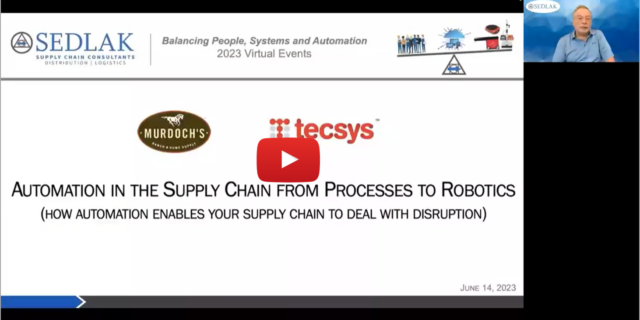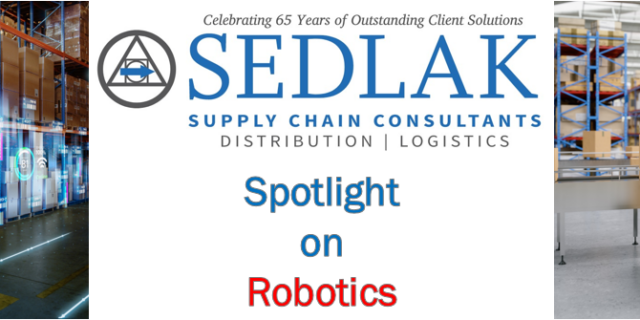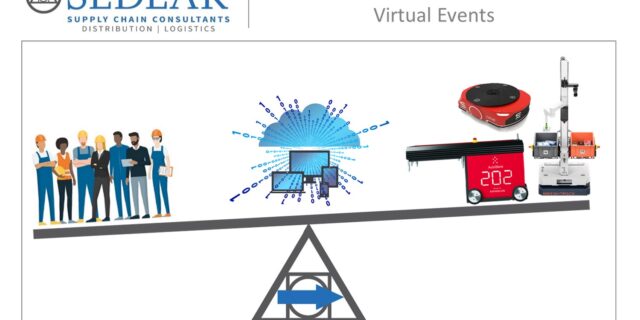Security, Labor, Cost, Efficiency: Material Handling Automation in Healthcare
October 14, 2016 By: Patrick S. Sedlak | Topics: Healthcare, Material Handling Systems Solutions, Productivity & LaborWhile decisions around distribution operations and the levels of automation in those environments are varied in the healthcare industry, a key driver for some companies is overall organizational strategy rather than a specific focus on security, labor, cost or efficiency. Regardless, there is awareness in the pharmaceutical industry that distribution centers and processes are on the brink of change, and new supply chain requirements and opportunities, as well as declining automation costs, are gradually making mechanization more attractive to the industry.
Sedlak facilitated two 30-minute roundtable events on the topic of distribution operations and automation at the LogiPharma conference which took place in Princeton, New Jersey, September 20-22. A summary of these discussions follows.
Overview/Opening Remarks
To set the stage for the discussion, the following trends specific to warehousing/distribution were highlighted:
- Continuing trend of increases in pharma theft
- Highest rates of theft/security generally from the internal labor pool
- Warehouse worker labor shortage (more warehouses, shift to distribution center-based online fulfillment away from stores)
- Decreasing costs in distribution automation technologies
The roundtable activities resulted in discussions regarding several general distribution/warehousing considerations:
Outsource/Insource Strategy
Across the two roundtables, the represented organizations pursued different outsource/insource strategies. Some outsourced all of their warehousing/distribution to one or multiple 3PL organizations; others built and managed their own distribution centers.
In outsourced environments, participants relied upon the 3PL providers to provide security within the distribution operations, oftentimes including security as a measure of performance in their overall 3PL provider scorecard. The decisions to outsource resulted from various factors, e.g., scale, focus, ability to allocate labor across multiple customers. Although labor shortages and challenges were discussed in these decisions, most of the participants had made little effort to pursue mechanization/automation beyond the basic capabilities of their 3PL providers. The reason was the typically short (usually 3- to 5-year) 3PL contract which, for the 3PL provider, diminishes the appeal of investing in more sophisticated mechanization/automation.
The advent of additional requirements such as UDI and track and trace in the healthcare arena is also driving interest in outsourcing more distribution functions to 3PL providers. In many instances, 3PL providers are in a strong position to offer related solutions as part of their overall value proposition.
For participants that own and operate their distribution centers, the decisions to do so were compelled predominantly by organizational strategy rather than security, labor, cost or efficiency factors. In these operations, the use of mechanization/automation was more prevalent but driven as much by operational efficiencies as by aspects related to security. This trend is likely to continue as consolidation continues across the industry, the cost of automation declines, product profiles change (e.g., increasing biologics, controlled substances, other specialty products) and shipping patterns evolve (i.e., more frequent and smaller shipments with increased delivery to end users).
Labor Factors
While participants were generally aware of the warehouse labor challenges starting to face other industries, there was little evidence of labor shortages affecting the roundtable participants. Some reported that the consistency of the work, relatively good work conditions, and competitive compensation helped drive good access to warehouse laborers even in relatively expensive labor markets.
Warehouse labor retention was generally high for all participants, whether in 3PL or company-owned operations. In some cases, retention was driven by poor local labor markets, but even in more competitive markets retention was sustainable due to other causes. In some instances when warehousing was outsourced, strong relationships built between the pharmaceutical shipper and the 3PL provider helped provide labor stability. Even though contract periods were only 3 years, contract renewal rates were high, leading to enduring relationships. This insight potentially adds justification for pursuing longer term contracts with 3PL providers.
Senior or more experienced warehouse laborers potentially come with higher costs due to salaries/benefits and incentives; however, those additional labor costs are easily offset by the value of retaining a trained and experienced workforce.
Dis-aggregation/Re-aggregation Needs
Regulatory requirements to serialize products at the “smallest saleable unit” have created challenges across the supply chain with regard to physically scanning and tracking individual items shipped in aggregate quantities. Depending on the operational processes and product volumes, one emerging challenge is the need to dis-aggregate and re-aggregate products to accommodate scanning and tracking requirements. While this roundtable did not focus specifically on this challenge, or on track and trace activities in general, discussions about how various organizations are addressing the requirements did ensue. This very relevant digression reflected the activity underway to comply with track and trace regulations. As processes and technologies are implemented to support track and trace initiatives, warehouse operations and processes will undoubtedly be impacted either directly or indirectly.
Returns Processes
Similar to general warehouse operations, some participant organizations outsourced their returns processes, while others managed the processes themselves. In response to increasing returns activity, many 3PL providers offer value added services that manage both saleable and non-saleable returns activities in an integrated fashion with their pharmaceutical customers. This can incorporate multiple functions, from the start of the returns process all the way through receipt and appropriate disposition, including disposal of hazardous waste and witnessed incineration of controlled substances. As consolidation brings more products into an organization’s portfolio, related returns volumes can increase, leading to economies of scale in these activities as well.
The Changing Role of Warehouses
As cost reduction initiatives influence lower cycle times and inventory levels, and the trend toward biologics changes the handling characteristics and shelf life of pharmaceutical products, the participants agreed that the role of pharmaceutical warehouses is poised to change at a more rapid pace. Ongoing industry consolidation and new technologies like driverless trucking, visibility/velocity enabled cross dock programs, and more affordable mechanization/automation are expected to impact the warehouse of the future. The pace of change seems to be the bigger unknown when compared to the likelihood of change.
Good-to-Person Picking Concepts
Several factors have fueled the increase of good-to-person concepts across industries, including SKU proliferation, increased just-in-time picking, greater picking accuracy requirements, and the push to improve efficiency by reducing travel time, to name a few. Similar issues are starting to affect activities in pharmaceutical warehouses.
In a goods-to-person system, inbound product is removed from pallets/cases either manually or automatically. Cases or units are then usually placed into totes/bins and stored in a high density carousel system or automated storage and retrieval systems (ASRS), or another robotic-enabled infrastructure. Warehouse information system applications provide picking instructions to a stationary order picker as the automated system transports the product to the order picking station. These stations are usually designed for ergonomics, efficiency and high productivity, and eliminate nearly all of the travel and “search” time involved in traditional person-to-goods warehouse designs.
Goods-to-person processes allow for very dense storage mechanisms, improved labor efficiency, and increased security in more controlled settings. These systems are becoming more feasible due to the advent of improved technologies, both in the hardware and software required to operate them. In addition, the modular nature of these systems make them more flexible than traditional warehouse automation approaches.
Analyzing the Inflection Points for Mechanization/Automation
Historically, the high costs of automation required relatively significant scale in predominantly fixed process environments to justify the investment. With pharmaceutical environments being historically fragmented and reasonably dynamic due to patent life and other factors, warehouse automation tended to be limited both in outsourced and insourced settings. Over time, mechanization and some early adopting technologies like voice-directed picking, bar coding and scanning, and other techniques gained acceptance because the desired cost/benefit and return on investment could be achieved.
With increased volumes, improved flexibility within mechanized solutions, and the overall downward trend in the cost of automation, the arguments against investment in warehouse automation are starting to subside. Once all pharmaceutical products are identified/serialized to meet other regulatory requirements, the “sunk cost” of those mandated investments could be leveraged into supporting additional efficiencies, changing the inflection point of the cost/benefit curve even more.
Sedlak is an industry leader in supply chain strategy and distribution, with a specialized practice in healthcare. Our solutions help optimize supply chain operations, balance cost/service trade-offs, and pursue intelligent growth strategies.
If there is any way we can support your healthcare supply chain or distribution optimization, please feel free to contact us by filling out the form below.







